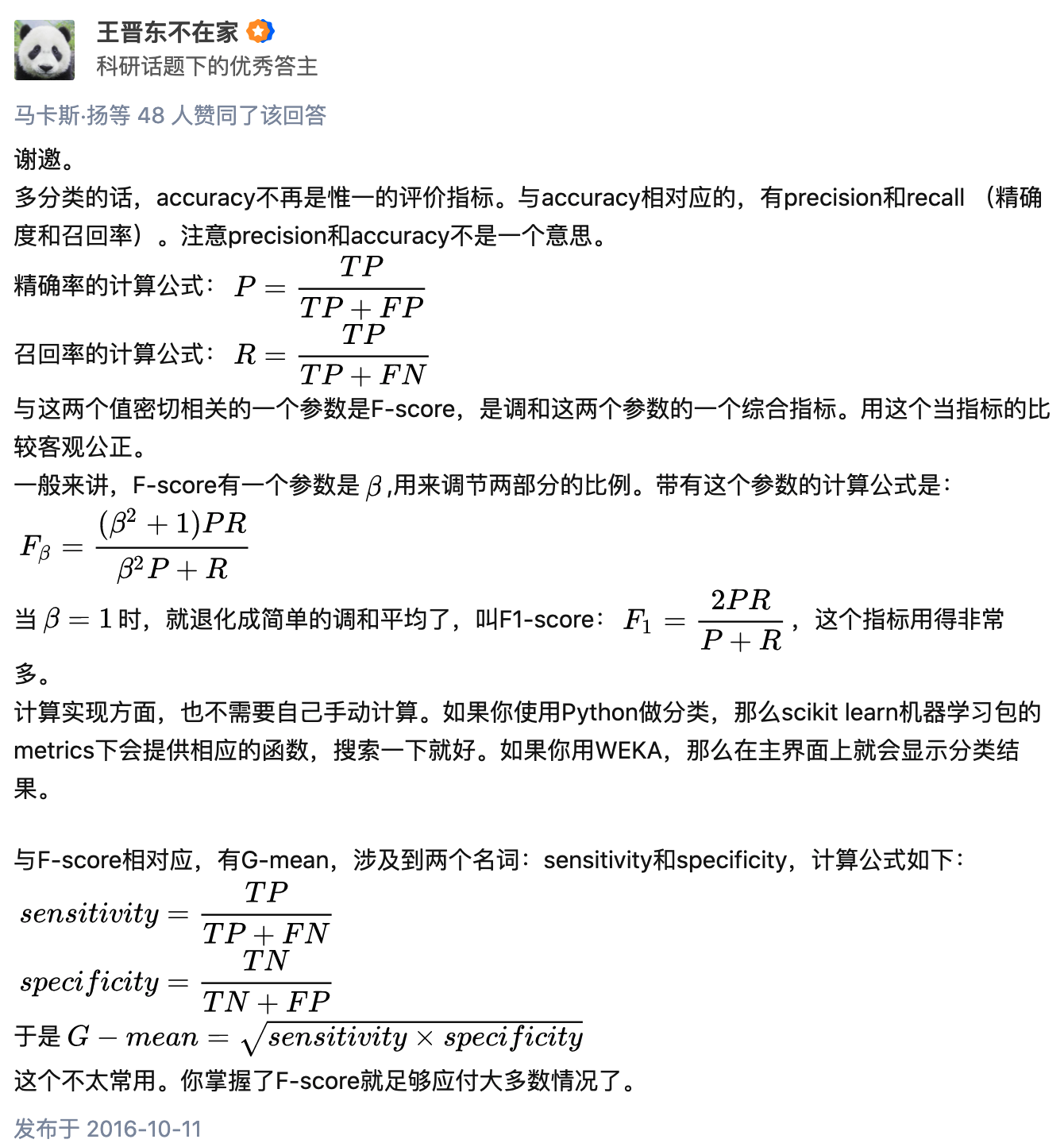多标签分类问题的评估
机器学习中有一类问题叫做多标签分类(multi-label),其和多分类(multi-class)问题不同。多分类问题是将一个样本x分到某一个类别$y_i$,而多标签分类问题是将一个样本x分到某些类别$y_i$, .., $y_j$等,也就是说多分类问题的类别之间是互斥的,所有类别的概率和为1。而多标签分类问题的类别之间不互斥,所有类别的概率和不为1,多标签分类问题可以理解为n个二分类问题。
最近在做一个多标签分类问题的工作,涉及到多标签分类问题如何评估效果,这里进行一些总结。
首先看下**多分类问题的评估**,知乎用户王晋东不在家已经讲的非常好了。

对于**多标签分类的评估**,上文已经说到,其可以看做是n个二分类问题,那么我们可以通过计算每个类别下的auc,综合起来对模型进行评估,这个其实很容易理解。但是在实现的时候需要注意几个问题:
tf2已经提供了多标签分类计算auc的函数,但是其综合了所有类别的auc,计算得到一个平均auc。如下所示,只需要指定multi_label=True就可以计算多标签分类的平均auc了。
1
2
3
4
5
6tf.keras.metrics.AUC(
num_thresholds=200, curve='ROC',
summation_method='interpolation', name=None, dtype=None,
thresholds=None, multi_label=False, num_labels=None, label_weights=None,
from_logits=False
)虽然tf2提供了多标签分类计算auc的函数,但是其计算的是平均auc,更多情况下我们希望看下每个类别的auc情况。所以还需要自己实现下。思路就是分别拎出各个类别的样本计算auc,计算某个类别auc的时候需要剔除其它类别的样本。同时因为tf提供的auc计算函数计算的是累积auc(就是计算auc的中间变量:真正例/假正例/真负例/假负例等本地变量值会累积),所以需要对每个类别的auc确定一个变量作用域,eg
with tf.compat.v1.variable_scope('class_' + str(class_id)):,避免计算出的各个类别auc之间相互干扰。分析源码得知,tf在计算真正例/假正例/真负例/假负例时,是通过metric_variable()函数定义了变量真正例,同时metric_variable()的实现也是依赖于variable_scope.variable,所以通过tf.compat.v1.variable_scope()可以避免各个类别的auc相互干扰。1
2
3
4
5
6
7
8
9
10
11def metric_variable(shape, dtype, validate_shape=True, name=None):
return variable_scope.variable(
lambda: array_ops.zeros(shape, dtype),
trainable=False,
collections=[
ops.GraphKeys.LOCAL_VARIABLES, ops.GraphKeys.METRIC_VARIABLES
],
validate_shape=validate_shape,
synchronization=variable_scope.VariableSynchronization.ON_READ,
aggregation=variable_scope.VariableAggregation.SUM,
name=name)上面也说了tf计算的是累积auc,所以需要区分自己想要的是batch auc还是累积auc。一个建议是,可以考虑在训练的时候计算batch_auc,观察auc的实时变化情况;预测的时候计算累积auc,观察整体效果。这个可以通过
tf.control_dependencies()控制。代码如下:1
2
3
4
5
6
7
8
9if is_training:
tf.compat.v1.add_to_collection(
tf.compat.v1.GraphKeys.UPDATE_OPS,
tf.compat.v1.local_variables_initializer())
update_ops = tf.compat.v1.get_collection(
tf.compat.v1.GraphKeys.UPDATE_OPS)
with tf.control_dependencies(update_ops), tf.compat.v1.variable_scope(
"train", reuse=tf.compat.v1.AUTO_REUSE):
train_op = optimizer.minimize(self.losses, global_step=global_step)tf.compat.v1.metrics.auc()函数的返回值有两个auc_value, update_op。需要先执行update_op,再执行auc_value。因为auc_value依赖于update_op先执行才会被更新。参见代码计算混淆矩阵的实现:1
2
3
4
5
6
7
8
9
10
11
12
13
14
15
16
17
18
19def _confusion_matrix_at_thresholds(labels,
predictions,
thresholds,
weights=None,
includes=None):
...
if 'fp' in includes:
false_p = metric_variable(
[num_thresholds], dtypes.float32, name='false_positives')
is_false_positive = math_ops.cast(
math_ops.logical_and(label_is_neg, pred_is_pos), dtypes.float32)
if weights_tiled is not None:
is_false_positive *= weights_tiled
update_ops['fp'] = state_ops.assign_add(false_p,
math_ops.reduce_sum(
is_false_positive, 1))
values['fp'] = false_p
return values, update_ops可以看到上述代码中,只有
update_ops['fp']先被执行,false_p才会被更新。其实也可以直接拿update_ops的值作为当前数据更新之后的auc。
参考:

